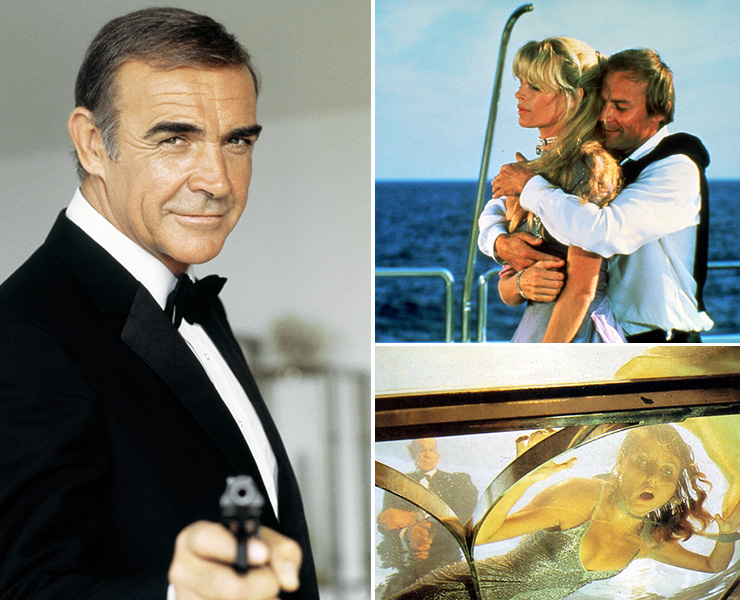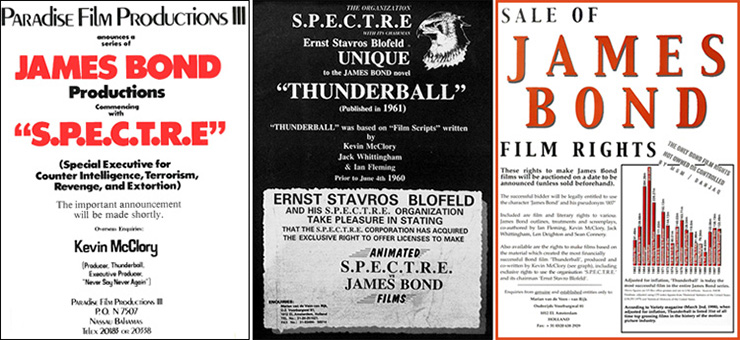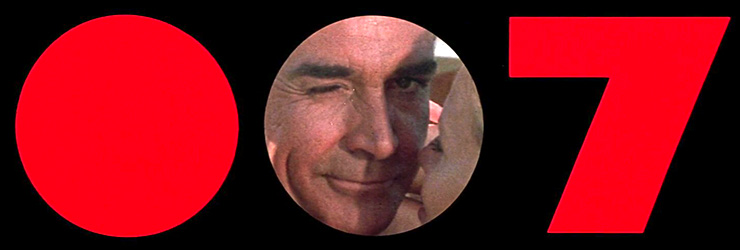|
Never Say |
||
|
||
|
Never Say |
||
|
||
 |
|
Although Never Say Never Again was privately financed, a domestic distributor was needed. Schwartzman chose Warner Brothers, “Part of it had to do with relationships. Part of it was that they had been exposed to the project when it was with McClory and was ‘Warhead’. They had done a substantial amount of research into the question of the rights. I didn’t have to slow down the deal with lawyers who had to re-evaluate everything.” Both Octopussy and Never Say Never Again were gearing for a head-to-head in cinemas in the Summer of 1983, but the anticipated box office showdown between the two films never materialised. Octopussy was a given a clear run after Never Say Never Again was rescheduled from a summer to a winter release. Whether this was due to legal or logistical reasons – or just plain common sense is unknown. Never Say Never Again did however survive a last ditch attempt to block its release, brought at the High Court in London by Ian Fleming’s trustees in the spring of 1983. The Trustees alleged that considerable secrecy had surrounded the making of Never Say Never Again. They had made no move to stop the film, apparently because they were unaware of its existence. On March 20, 1983, Mr Justice Goulding ruled that it was, “unjust and unfair to stop the film from reaching the cinema” at this stage and they had applied too late. Schwartzman was now free to release Never Say Never Again as soon as it was ready. Octopussy’s three-month lead may have been a contributing factor in Never Say Never Again’s weaker worldwide box office gross. Octopussy grossed $183,700,000 worldwide; while Never Say Never Again scored $55,432,000 in the USA, and £7,400,000 in the UK. Cubby Broccoli, however, did pick up a healthy 20% share of the profits from Never Say Never Again, due to a clause in the contract made with Kevin McClory in 1964 during their one-picture producing partnership for Thunderball. Sean Connery was quick to comment on the opposition, “I wasn’t that impressed with Octopussy. It opened with a marvellous stunt, which didn’t relate to the rest of the picture. In the end I just sat up and watched the stunts.” |
||||
|
||||
|
Never Say Never Again had its world premiere at the Mann National Theatre Westwood, Los Angeles on Thursday October 6, 1983, where it was screened in 70mm. The film then opened across the United States the following day and was met by rave reviews. Critic Roger Ebert hailed Connery’s comeback as, “One of those showbusiness miracles that never happen. There was never a Beatles reunion. But here, by God, is Sean Connery as Sir James Bond (sic).” Although many felt Connery looked as suave and sophisticated as ever back in the role, some still had their reservations as David Denby in The New York Magazine wrote, “When he makes Bond’s usual dirty puns, you feel a bit sorry for him.” In London the film premiered at Leicester Square’s Warner Theatre on Wednesday 14, December 1983, in the presence of Prince Andrew. Sean Connery attended together with his wife Micheline, and Brother Neil and his family. Former Bond girl Barbara Bach and her husband Ringo Starr were also present. But did Never Say Never Again deliver what it promised at the outset? Sean Connery told the New York Times, “One of the points I was after was to go back more into the vein of From Russia With Love.” |
||||
|
||||
|
Without doubt, the principal actors are great, the script boasts some witty dialogue, and, for its time, some decent, but now dated, special effects. Balanced against this there are elements of lacklustre direction, a disjointed story, and an uninspired musical score. It generally looks tired and washed out. The dry sense of humour is still there, but gone is the arrogant, cruel, hard, dangerous qualities that Connery originally brought to the role. It’s fair to say that Never Say Never Again has more in common with Diamonds Are Forever (1971) than From Russia With Love (1963). The film was in every sense of the word, an American Bond movie; directed by an American, from an American script, and made by an American studio, who thought they knew who and what James Bond was – but clearly didn’t. The pace of the film seems sedate, and the major action sequences, the motorbike sequence, horseback chase, and underwater action, all look staged and unimaginative. But the film did have some memorable sequences: the opening training exercise, Bond’s interview with M, and the foie gras, vodka and quails eggs suitcase sequence with Patricia had a well-placed sense of fun. Unfortunately Never Say Never Again failed to achieve its full potential, and after 12 years and numerous false starts it was as a bitter pill to swallow. In the final outcome, the film resembles a clapped-out television spy movie, it just doesn’t feel like a ‘James Bond Film’, and is nowhere near as stylish or sophisticated as the film it purports to replicate. It’s a mystery why Octopussy is never used as a truncheon to beat the living daylights out of Never Say Never Again. The former is far superior and is sufficient evidence to prove that no one other than Albert R. Broccoli’s EON Productions knew and understood the concept of making James Bond movies. |
||||
|
||||
|
During the worldwide promotions for Never Say Never Again, Connery was adamant that this would be his swansong as James Bond, but then again this became a set party piece for him at the end of every Bond movie. After his fifth 007 outing, You Only Live Twice (1967), he even told The Queen at the London premiere he wanted out of Her Majesty’s Secret Service! He joked with Barry Norman on Film 83, “Roger and I will play M, and show them the ropes and all that nonsense!” In more recent years he’d been touted as returning as a villain in EON’s series rather than James Bond himself! He said in 1995, “I’m too old to play Bond. I don’t think I would play a villain, unless it was really a marvellous part… and $7 million.” Ironically Sean Connery did return to the role of James Bond one last time in 2005, when he provided his voice and likeness for From Russia With Love – a third-person shooter video game developed by EA Redwood Shores and published by Electronic Arts. |
||||
 |
||||
|
Years after Never Say Never Again was released, producer Jack Schwartzman revealed, “It was the first film I had produced on my own. And I actually underestimated what I was getting into. There were substantial cost overruns, all of which came out of my own pocket, so in effect, I paid the price of my own shortcomings.” He also revealed that if he had been given the job all over again, he would have made the same picture, but he would have spent the money more efficiently, and would have developed better relationships with his team. The producer also commented that he would have hired a different composer – James Horner, who became one of Hollywood’s leading film composers. Schwartzman claimed that Connery rejected Horner over Michel Legrand. Jack Schwartzman died aged 62 on June 14, 1994 of pancreatic cancer. After Never Say Never Again, Kevin McClory soon began making plans to make a third movie from his rights to the ‘Thunderball scripts’. On July 20, 1989, just weeks after the release of EON’s sixteenth 007 adventure, Licence To Kill, McClory announced his latest project – ‘Warhead 8’. A press release from his new company, The SPECTRE Corporation Inc., informed the industry he was “close to completing a deal that will reintroduce the ‘SPECTRE organisation’ with its Chairman Ernst Stavros (sic) Blofeld, and yet again another actor, to play their original protagonist James Bond.” It continued, “The new film will be filmed in Australia, Ireland and New York City.” McClory told TV Week Magazine that he had been talking with none other than Pierce Brosnan about the role. He said, “I talked to Pierce in Ireland, but at this stage it’s not in our interests to comment.” He continued by adding, “We’ve got quite a lot of underwater filming to do, and a fair amount will be done on the Great Barrier Reef. With the Bond films I’ve been involved in, we tend to be into sharks, and you’ve got plenty. We’re going back to the early formula. We were the innovators of transforming Ian’s novels into film.” He concluded by commenting upon the then current James Bond Timothy Dalton, “I enjoyed Licence To Kill. Timothy Dalton is a fine actor.” Unsurprisingly, ‘Warhead 8’ was never made. In 1992, Kevin McClory announced a James Bond television series based on his rights. This idea also failed to surface. But McClory really made EON Productions and the MGM Studio executives sit up in 1996, when the producer entered into negotiations with Sony Pictures, with the idea of a series of James Bond films based on the ‘Warhead files’. McClory had interested Sony executive Gareth Wigan, whom he had known from 1960’s London. The idea also interested the newly appointed Sony chairman John Calley. He had come fresh from United Artists and had been paramount in overseeing the re-launch of EON’s James Bond franchise with Pierce Brosnan in the mid-Nineties. Calley knew previously of McClory’s rights, as reportedly he was involved in pursuing Sean Connery to return in Never Say Never Again. |
||||
 |
||||
|
Before long, rumours were flying of Connery yet again returning as 007 in the new Sony picture. One studio source hinted, “Sean Connery has been approached and he is very interested.” Connery on the other hand denied all rumours. In October 1997, just weeks before the worldwide premiere of Pierce Brosnan’s second 007 adventure Tomorrow Never Dies, Sony Pictures made their announcement that they had acquired Kevin McClory’s rights and would be setting up a new franchise of James Bond films, the first being titled ‘Warhead 2000 A.D.’ Not surprisingly, MGM once again filed suit. Sony counter-sued in early 1998 claiming that Kevin McClory helped create the cinematic James Bond character. The long legal debate was finally settled in 2001 when Sony lost their case. The rights to the screen incarnation of James Bond now lay firmly in the hands of MGM and EON Productions. As part of their settlement, MGM also acquired the rights to both Casino Royale (1967) and Never Say Never Again (1983), and now have total control over every one of 007’s cinematic adventures. In 2013, seven years after Kevin McClory’s death, DANJAQ LLC and MGM Studios announced they had then acquired all the rights and interests relating to James Bond from the late producer’s estate. This allowed them to reintroduce the character of Ernst Stavro Blofeld and his criminal organisation for a new generation of cinemagoers in Spectre (2015). No doubt Bond fans will continue to debate the value of Never Say Never Again as a ‘Bond film’ for years to come, however, there should be no debate about the fact that it is a ‘Bond film’ – just not a very good one! |
||||
 |
||||
|
|